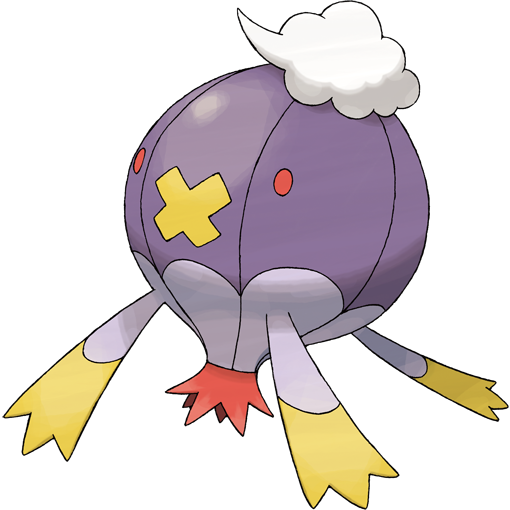Safari Ball - The Story of Drifloon

Welcome to Safari Ball, a field guide series that explores how Pokémon evolve through behavior, emotion, and environment.
Sometimes, when the fog clings low and the wind barely moves, you might spot something drifting just above the ground. Not quite a balloon, not quite a cloud. It floats gently, with heart-shaped hands and a quiet pull that feels like memory. This is Drifloon, the Ghost/Flying-type Pokémon said to be born from wandering souls. But if you follow its path through the sky long enough, you’ll see it change, growing not just larger, but quieter, more solemn. Let’s step into their world where emotions don’t vanish, but rise.
👻 Want to dive deeper on the personality traits of a Ghost-type?
Drifloon
“Because of the way it floats aimlessly, an old folktale calls it a "Signpost for Wandering Spirits.”
—Pokémon Platinum
Drifloon lives near old graveyards, damp forests, and forgotten paths. Places where the air feels thick with grief, memory, or waiting. It prefers these places not just for their quiet, but because they hold emotional echoes. In those echoes, Drifloon feels less alone. The Pokémon Diamond entry tells us: “A Pokémon formed by the spirits of people and Pokémon. It loves damp, humid seasons.”
Its body is filled with air and the lost souls of those who’ve passed on. But the most striking part? Its two stringy arms end in yellow heart-shaped hands. These aren’t just cute design choices, they’re symbols of emotional longing. Yellow is often tied to hope, friendship, or warning. And for Drifloon, those hearts are its way of reaching out, a soft ask for connection.
But why children?
It’s not because Drifloon is evil. It’s because children still believe in things adults often forget. They reach out without fear. They listen without logic. Pokémon Ultra Moon says: “When trying to make friends with children, Drifloon grabs them by the hand.” But Drifloon is light and easily pulled around, so children who play too rough scare it. According to Pokémon Sword, “It approaches children… but often quickly runs away when the children play too roughly with it.”
This behavior points to something tender. Drifloon doesn’t want to be alone. But it also doesn’t want to be hurt. It chooses the innocence of children because they’re more likely to see it as it truly is, even if that innocence fades too quickly.
Of course, stories warn of children vanishing. Pokémon Sun writes, “It grabs the hands of small children and drags them away to the afterlife.” Whether these tales are true or not, they’ve shaped how people see Drifloon, with fear, suspicion, even sorrow. And so, Drifloon becomes a misunderstood ghost, feared for what people think it might do, rather than what it means to.
It’s no wonder old folktales call it “a signpost for wandering spirits” (Pokémon Platinum). A signpost doesn’t act, it points the way. Drifloon isn’t the destination. It’s the reminder. The signal that someone or something is still looking for closure. Still looking for home. Sometimes, being misunderstood feels like standing in a room full of people and still feeling invisible. Like speaking, but not being heard. Drifloon reminds us of that ache and of how hard it is to keep reaching out when no one really sees you.
But one day, Drifloon stops reaching. It begins to carry instead.
Drifblim
“Some say this Pokémon is a collection of souls burdened with regrets, silently drifting through the dusk.”
—Pokémon Sword
By Level 28, Drifloon evolves into Drifblim, a larger, rounder Pokémon that no longer tugs at sleeves or seeks out playmates. Instead, it becomes something more mysterious, a vessel. A ferry for feelings we haven’t finished feeling. Pokémon Ultra Moon says, “The raw material for the gas inside its body is souls.”
Drifblim no longer reaches for companionship. It carries weight, sometimes physically, sometimes emotionally. Pokémon Shining Pearl describes: “It carries people and Pokémon when it flies. But since it only drifts, it can end up anywhere.” That detail, it can end up anywhere, tells us something powerful. Drifblim doesn’t control its journey. It lets the wind decide.
This lack of control feels symbolic. After loss, or regret, or big life change, sometimes we float too. We move forward, not because we know the way, but because something carries us through. Drifblim becomes a symbol for that surrender. The part of grief where we’re no longer fighting the tide, just letting it carry us where we need to go. But what kind of weight does Drifblim hold? What are the souls made of?
Sometimes they’re memories we can’t stop replaying. A goodbye that came too soon. Sometimes they’re regrets, things we wish we’d said. Other times they’re just the feeling of being lost, drifting through life without a clear direction. Drifblim doesn’t run from these feelings. It carries them. And somehow, in that drifting, there’s healing. Compare this to Drifloon. Drifloon clings to children, to memory, to connection. Drifblim releases. It doesn’t ask for hands anymore. It offers a quiet ride for those emotions, those souls, those stories to go wherever they’re meant to.
Drifloon carries children. Drifblim carries everything they leave behind.
Drifloon used Destiny Bond
Drifloon and Drifblim share the Ghost/Flying-type, but emotionally they are mirrors in motion. One yearns, the other yields. One tugs, the other lifts. Drifloon teaches us how deep the need for connection can run. Drifblim shows us what it means to carry something without being crushed by it. Together, they teach us that grief can become grace, and longing can lead to freedom — if we learn to float, not just hold.
Sometimes, the scariest part of letting go is trusting the wind to carry you.
🎧 Want stories about the real lives of Pokémon trainers?
🎙️ Check out my podcast where I interview everyday Pokemon fans, collectors, and players!
▶️Available here or your favorite podcast app!




